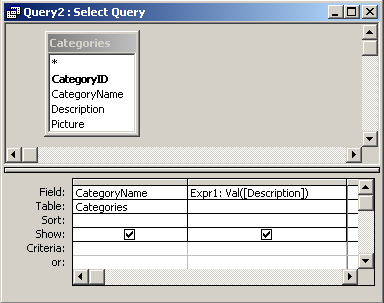
MS Access: Val Function
This MSAccess tutorial explains how to use the Access Val function with syntax and examples.
Description
The Microsoft Access Val function accepts a string as input and returns the numbers found in that string.
Val( string ) function only seems to work when the number in that string is at *the beginning* of said string.Syntax
The syntax for the Val function in MS Access is:
Val ( string )
Parameters or Arguments
- string
- A string expression.
Note
- The Val function will stop reading the string once it encounters the first non-numeric character. This does not include spaces.
- If no numeric value is found at the start of the string, the Val function will return 0.
Applies To
The Val function can be used in the following versions of Microsoft Access:
- Access 2019, Access 2016, Access 2013, Access 2010, Access 2007, Access 2003, Access XP, Access 2000
Example
Let's look at how to use the Val function in MS Access:
Val ("10 Main Street")
Result: 10
Val ("34 10 Main Street")
Result: 3410
Val (" 34 10 Main Street")
Result: 3410
Val (" 34 - 10 Main Street")
Result: 34
Val ("075")
Result: 75
Val("There are 5 houses")
Result: 0
Example in VBA Code
The Val function can be used in VBA code in Microsoft Access.
For example:
Dim LNumber As Double
LNumber = Val ("56.2 tables")
In this example, the variable called LNumber would now contain the value of 56.2.
Example in SQL/Queries
You can also use the Val function in a query in Microsoft Access.
For example:

In this query, we have used the Val function as follows:
Expr1: Val([Description])
This query will return the starting numeric values from the Description field and display the results in a column called Expr1. You can replace Expr1 with a column name that is more meaningful.
For example:
NumericValue: Val([Description])
The results would now be displayed in a column called NumericValue.
Advertisements



